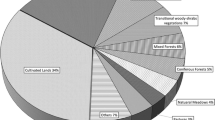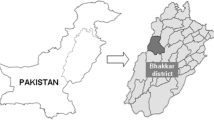Abstract
The developing countries of the Pacific Region consist of 27 countries and territories with a total nd area of 542 000 km2 and over 5 million inhabitants. Though highly variable in physical characteristics and land-use pattern, these countries, in general, give a higher priority for production of export crops over other agricultural crops, so that they are net importers of food. Natural forests of the region are luxuriant and floristically rich, but the level of their commercial exploitation is low. Swidden cultivation is the mainstay of subsistence livelihood, but with the increase in population, the system is now causing severe environmental and land-use problems.
The major agroforestry systems and practices in the region include various forms of combination of tree crops such as coffee, coconut and cacao with nitrogen fixing trees such as Casuarina, Gliricidia and Leucaena, and food crops (mostly tubers) such as cassava, taro, sweet potato and yams. Additionally, some improvements to swidden (shifting) cultivation are also being tried in several places, the most common being the u use of Casuarina oligodon before abandoning the swidden as in PNG highlands, and intercropping food crops in tree crop stands.
Land tenure system in most of the countries is the traditional clan of extended family control over land. This can have either positive or negative influence on the adoption of agroforestry practices depending on the extent and duration of ‘tenancy’ tenure enjoyed by the assignees of land.
Several governments of the region are now promoting the agroforestry approach. In hilly areas with poor access, farmers are forced to produce most of their basic necessities locally. On the other hand, the lack of roads and communication facilities can pose a problem in marketing any surplus products they have.
The immediate opportunity in agroforestry in the region lies in making better use of the unexplored potential of a large number of locally available trees and agricultural crops. Intercropping in tree crop stands and the taungya system seem to propromising m methods for the Pacific region.
Similar content being viewed by others
References
Bourke RM(1985) Food, Coffee and casurarina: an agroforestry system from the Papua New Guinea highlands. Agroforestry Systems 2:273–279
Carrad B (1982) Economic aspects of smallholder practices: mixed cropping of food and coffee. In: Bourke RM and Kesavan V (ed.) Proceedings of the Second Papua New Guinea Food Crops Conference, pp 294–302. Port Moresby, PNG: Department of Primary Industry
Dahl AL (1980) Regional Ecosystems Survey of the South Pacific. Tech Rep 179. Noumea: South Pacific Commission
FAO (1979) FAO Agricultural Commodity Projections 1975–1985. Rome: FAO
FAO (1981) FAO Production Year Book Vol 34, 1980. Rome: FAO
Hamnett MP and Franco AB (1982). Regional overview of disaster preparedness and disaster experience in the Pacific. Honolulu: East-West Center Pacific Island Development Program
IUCN (1982) World Conservation Strategy. Gland, Switzerland: International Union for Conservation of Nature and Natural Resources
Richardson SD (1983). Agroforestry and the Pacific Islands. In: SchirmerA (ed), (9), pp 53–70
Schirmer A (ed.) The Role of Agroforestry in the Pacific. Eschborn, Germany: DSE (German Foundation for International Development)
Smith MA(1983) Grazing studies on the Guadalcanal Plains, Solomon Islands. M Agr Sc Thesis, Univ of Queensland
Smith MA and Whiteman PC (1983a) Rotational grazing experiment under coconuts at Lingatu Estate, Russell Islands. Tech Rep Dept of Agric Univ Queensland
Smith MA and Whiteman PC (1983b) Evaluation of tropical grasses in increasing shade under coconut canopies. Expl Agric 19:153–161
Thaman RR and Clarke WC (1983). Pacific Island agrosilviculture: systems for cutured and ecological stability. In Schirmer A (ed), (9), pp 44–52
Thiagalingam K (1983) Role of casuarina in agroforestry. In: Midgley SJ, Turnbull JW and Johnston RD (ed). Casuarina Ecology Management and Utilization, pp 175–179. Melbourne: CSIRO
Yang YH (1979) Agricultural pattern and nutritional status of people n the South Pacific Countries. Paper for the 14th Pacific Science Congress, Khabroust, USSR
Author information
Authors and Affiliations
Additional information
Researh Fellow, July–September, 1984
Rights and permissions
About this article
Cite this article
Vergara, N.T., Nair, P.K.R. Agroforestry in the South Pacific region — an overview. Agroforest Syst 3, 363–379 (1985). https://doi.org/10.1007/BF00055718
Issue Date:
DOI: https://doi.org/10.1007/BF00055718




